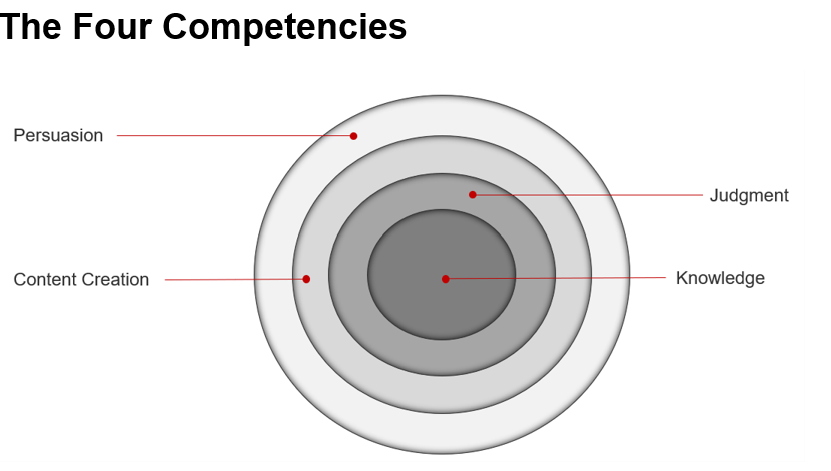Generative AI (artificial intelligence) is going to upend the labor market. This is old news. Every week we see a new analyst publication giving us their numbers.[1] Lawyers comfort themselves with the view that “a machine will never be able to replace us” in the exercise of professional judgment and interpersonal engagement. But even for those sacred duties, change is coming.
The four professional competencies
For lawyers—and indeed professionals generally—functional competency can be whittled down to the following:

At the core is Knowledge:
- applicable laws and regulations;
- the client’s business: operational features, commercial approach, and priorities; and
- market/industry practice and content standards.
Surrounding this core is what you might call the ring of power—Judgment. The ability to make the right decisions around things such as:
- risk parameters
- content look and feel
- narratives
- interpersonal and organizational dynamics
- how to balance commercial and operational drivers
The next functional competency is Content Creation. Historically, content creation was all about written communications, but these days you can include numerical (e.g., Excel) and graphic (e.g., PowerPoint[2]) forms as well. And let’s not forget those most fashionable outputs in the legal ops world: workflows and process designs.
Finally, we have Persuasion, which has always been the lawyer’s superpower. Persuasion is the competency that executes with maximum effectiveness the delivery of all that knowledge, judgment, and content and is a more pervasive activity than you might think. Examples of persuasion are:
- counterparties (negotiations);
- clients (pitches, advice);
- colleagues (training, coaching, leadership); and
- market (thought leadership, events, and presentations).
Bringing these competencies together is Experience, which we define as the effective use of judgment based on knowledge acquired through sufficient practice. That’s a functional definition, as distinct from simply having “twenty-five years of experience in reviewing NDAs in the noodle packaging sector.”
Here comes the machine
AI will play an increasingly central role in the performance of all of these competencies, and not just knowledge and content creation, which are the industry’s current focus. As the available datasets grow, and as practitioners and service providers invest in the design and build of new use cases, the ability of AI systems to accumulate, organize, summarize, extract, and pattern-sift information will augment how lawyers come to form their judgments and the tools available for persuasion. For example:
Competency | AI use case |
Judgment | Identify the client’s most commonly negotiated final contract positions for a particular business line over the last X number of years. Compare with client’s current playbook, and update playbook positions accordingly. |
Create a standardized methodology for measuring and analyzing client escalations, considering type/category, business line, region, organizational level of origin, response delay, and other relevant factors. | |
Analyze service-level agreement (SLA) financial penalties credited to clients over the last X number of years, categorizing by service line, region, length of client tenure, and other relevant factors. Cross-reference contract profile (deal value, margin, length of time for the opportunity pursuit, and nature of pursuit—e.g., RFP, direct approach). | |
Persuasion | Condense a ten-page advice note into an executive summary of five paragraphs, using non-legalistic language and focusing on impact upon the client’s business. |
Create two heat maps to share with a counterparty in negotiations: the first highlighting the current biggest gaps between the negotiating parties in the main contract terms, the second identifying the most common areas of commercial dispute between customers and suppliers in the relevant sector, according to available data. Note: this type of analysis will likely support the work of World Commerce & Contracting[3] in identifying the gap between most negotiated terms and the contractual areas most frequently disputed in practice. The analysis might then help to persuade the two sides to be pragmatic on the former and free up time to pay close attention to the latter. | |
What next?
What does all this mean for junior lawyers looking at the road ahead? In a word: opportunity. AI is going to open up access to new realms of data and new methods of exploiting that information. Exercising legal judgment will be increasingly based on real data rather than precedent, anecdote, or simply years in the field. The skill of persuasion may become ever more artful in the use of infographics, and in tracking what works and what does not. So here are three things the new generation of lawyers should be thinking about as they consider the brave new world of AI-enabled lawyering:
- If your job is all about risk assessment, ask yourself how much of that risk assessment is currently based on hard data.
- Can AI increase the amount of hard data that you are using in your risk assessments?
- Can AI improve the ways you can present your analysis, so that you can be more persuasive?
Understanding the limits of current generative AI tools—and especially the limitations of the data pools which have trained those tools—will be a key skill for the new generation of legal professionals. The AI is not self-aware and is not exercising its own judgment. It has no idea what you intend to do with its output, but its ability to inform your judgment and enhance your persuasiveness will be transformative.
Check out, for example, McKinsey Global Institute’s July 2023 report Generative AI and the Future of Work in America. ↑
Other office productivity brands are available. ↑
See, e.g., World Commerce & Contracting Most Negotiated Terms report, 2022. ↑


